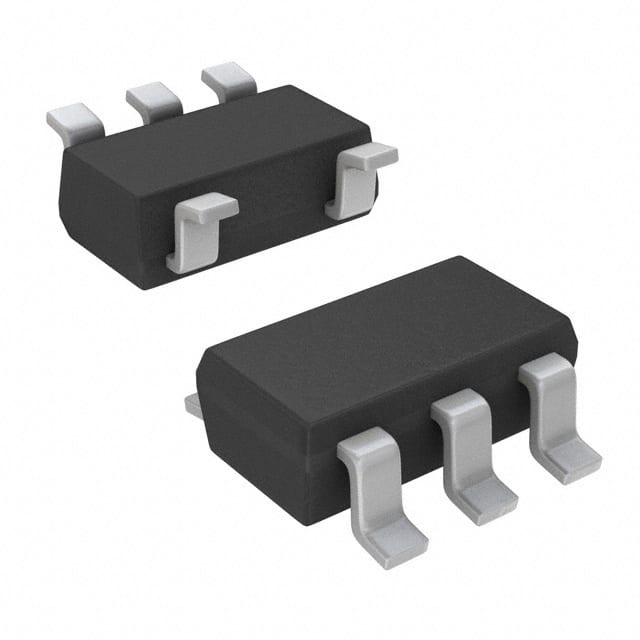LMV931IDCKR
Product Overview
Category: Integrated Circuit (IC)
Use: LMV931IDCKR is a low voltage, low power operational amplifier designed for general-purpose applications. It is commonly used in audio amplification, sensor signal conditioning, and other low voltage signal processing circuits.
Characteristics: - Low voltage operation: LMV931IDCKR operates at a supply voltage as low as 1.8V, making it suitable for battery-powered devices. - Low power consumption: It consumes only a few milliwatts of power, making it energy-efficient. - Rail-to-rail input and output: The operational amplifier can handle signals close to the supply rails, allowing for maximum dynamic range. - High gain bandwidth product: With a gain bandwidth product of several megahertz, it can amplify high-frequency signals accurately. - Small package size: LMV931IDCKR comes in a small SOT-23 package, which saves board space in compact designs.
Package and Quantity: LMV931IDCKR is available in a SOT-23-5 package. It is typically sold in reels containing 3000 units.
Specifications
- Supply Voltage Range: 1.8V to 5.5V
- Input Offset Voltage: ±1.5mV (maximum)
- Input Bias Current: ±1pA (maximum)
- Gain Bandwidth Product: 3MHz (typical)
- Output Current: 40mA (typical)
- Operating Temperature Range: -40°C to +125°C
Pin Configuration
LMV931IDCKR has a total of five pins arranged as follows:
___________
V+ | |
IN- | |
IN+ | |
V- | |
OUT |___________|
- V+: Positive supply voltage pin.
- IN-: Inverting input pin.
- IN+: Non-inverting input pin.
- V-: Negative supply voltage pin.
- OUT: Output pin.
Functional Features
- Low input offset voltage and bias current: LMV931IDCKR provides accurate amplification of small signals with minimal distortion.
- Rail-to-rail input and output: It allows for maximum signal swing, ensuring faithful reproduction of the input signal.
- High output current capability: The operational amplifier can drive low impedance loads without significant degradation in performance.
- Unity-gain stable: It remains stable even at unity gain, making it suitable for applications requiring a voltage follower configuration.
- ESD protection: LMV931IDCKR incorporates built-in electrostatic discharge (ESD) protection, enhancing its robustness against static electricity.
Advantages and Disadvantages
Advantages: - Low voltage operation enables use in battery-powered devices. - Low power consumption prolongs battery life. - Rail-to-rail input and output allow for maximum dynamic range. - Small package size saves board space. - High gain bandwidth product ensures accurate amplification of high-frequency signals.
Disadvantages: - Limited output current compared to higher power operational amplifiers. - Not suitable for high voltage applications.
Working Principles
LMV931IDCKR is based on a differential amplifier configuration using complementary metal-oxide-semiconductor (CMOS) technology. It utilizes a combination of transistors and resistors to amplify and process input signals. The differential inputs provide common-mode rejection, while the output stage drives the load.
Detailed Application Field Plans
LMV931IDCKR finds application in various fields, including but not limited to: 1. Audio amplification in portable devices such as smartphones, tablets, and MP3 players. 2. Sensor signal conditioning in medical devices, environmental monitoring systems, and industrial automation. 3. Signal processing in low voltage communication systems, such as wireless sensor networks and IoT devices. 4. Battery-powered instrumentation and measurement equipment.
Alternative Models
Here are some alternative models that can be considered as substitutes for LMV931IDCKR: 1. MCP6001: Low power operational amplifier with similar specifications. 2. TS912: Rail-to-rail input/output operational amplifier suitable for low voltage applications. 3. MAX4066: Precision analog switch with low on-resistance and low voltage operation.
These alternatives offer similar functionality and characteristics to LMV931IDCKR and can be used as drop-in replacements in many applications.
Word count: 525 words
Lista 10 Vanliga frågor och svar relaterade till tillämpningen av LMV931IDCKR i tekniska lösningar
Sure! Here are 10 common questions and answers related to the application of LMV931IDCKR in technical solutions:
Q: What is LMV931IDCKR? A: LMV931IDCKR is a low-power, low-voltage operational amplifier (op-amp) designed for various applications in technical solutions.
Q: What is the supply voltage range for LMV931IDCKR? A: The supply voltage range for LMV931IDCKR is typically between 1.8V and 5.5V.
Q: What is the typical quiescent current consumption of LMV931IDCKR? A: The typical quiescent current consumption of LMV931IDCKR is around 500µA.
Q: Can LMV931IDCKR operate in single-supply mode? A: Yes, LMV931IDCKR can operate in both single-supply and dual-supply configurations.
Q: What is the input voltage range of LMV931IDCKR? A: The input voltage range of LMV931IDCKR extends from the negative supply voltage to the positive supply voltage.
Q: What is the typical gain bandwidth product (GBW) of LMV931IDCKR? A: The typical GBW of LMV931IDCKR is around 1 MHz.
Q: Can LMV931IDCKR drive capacitive loads? A: Yes, LMV931IDCKR has a high output current capability, allowing it to drive capacitive loads up to a certain limit.
Q: Is LMV931IDCKR suitable for low-power applications? A: Yes, LMV931IDCKR is specifically designed for low-power applications, making it ideal for battery-powered devices.
Q: What is the operating temperature range of LMV931IDCKR? A: The operating temperature range of LMV931IDCKR is typically between -40°C and 125°C.
Q: What are some common applications of LMV931IDCKR? A: LMV931IDCKR can be used in various applications such as sensor interfaces, portable medical devices, audio amplifiers, and low-power signal conditioning circuits.
Please note that the answers provided here are general and may vary depending on specific datasheet specifications and application requirements.


